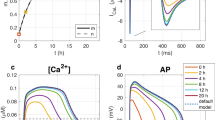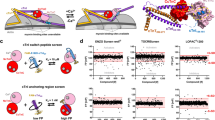Abstract
Many excitable cells contain at least two different voltage-dependent Ca channels (L- and T-type)1–3. The cardiac, slow, L-type Ca channel is further modulated by cyclic AMP-dependent phosphorylation4–7, which increases the probability of it being open5,7, and is readily blocked by Ca channel blockers including dihydro-pyridines and phenylalkylamines8–11. The tritiated congeners of these blockers bind in vitro to sites which have the same pharmacological characteristics as those observed in vivol2–l4 that is, stereospecific and allosteric interaction between distinct sites. The dihydropyridine-binding site purified from skeletal muscle t-tubules15 contains three peptides of relative molecular mass (Mr) 142,000 (142K), 56K and 31K. The cAMP kinase incorporates one mol phosphate per mol of the 142K peptide and binding of (+)PN-200/110, a potent Ca antagonist, is allosterically affected by D-cis-diltiazem and verapamil. The purified dihydropyridine-receptor complex has also been incorporated into phospholipid bilayer membranes. Here, we show for the first time that the complex can be reconstituted to form a functional 20-pS Ca channel that retains the principal regulatory, biochemical and pharmacological properties of membrane-bound L-type Ca channels.
This is a preview of subscription content, access via your institution
Access options
Subscribe to this journal
Receive 51 print issues and online access
$199.00 per year
only $3.90 per issue
Buy this article
- Purchase on SpringerLink
- Instant access to full article PDF
Prices may be subject to local taxes which are calculated during checkout
Similar content being viewed by others
References
Carbone, E. & Lux, H. D. Nature 310, 501–502 (1984).
Bean, B. P. J. gen. Physiol. 86, 1–30 (1985).
Nilius, B., Hess, P., Lansman, J. B. & Tsien, R. W. Nature 316, 443–446 (1986).
Osterrieder, W. et al. Nature 298, 576–578 (1982).
Cachelin, A. B., de Peyer, J. E., Kokubun, S. & Reuter, H. Nature 304, 462–464 (1983).
Bean, W. P., Nowycky, M. C. & Tsien, R. W. Nature 307, 371–375 (1984).
Brum, G., Osterrieder, E. & Trautwein, W. Pflügers Arch. ges. Physiol. 401, 111–118 (1984).
Hess, P., Lansman, J. B. & Tsien, R. W. Nature 311, 538–544 (1984).
Sanguinetti, M. C. & Kass, R. S. Circulation Res. 55, 336–348 (1984).
McDonald, T. F., Pelzer, D. & Trautwein, W. J. Physiol., Lond. 352, 217–241 (1984).
Cavalié, A., Pelzer, D. & Trautwein, W. J. Physiol., Lond. 358, 59P (1985).
Glossmann, H., Ferry, D. R., Goll, A., Striessnig, J. & Zernig, G. Arzneim-Forschung/Drug Res. 35, 1917–1935 (1985).
Snyder, S. H. & Reynolds, I. J. New Engl. J. Med. 313, 995–1002 (1985).
Ruth, P., Flockerzi, V, v. Nettelbladt, E., Oeken, J. & Hofmann, F. Eur. J. Biochem. 150, 313–322 (1985).
Curtis, B. M. & Catterall, W. A. Biochemistry 23, 2113–2118 (1984).
Hanke, W., Methfessel, C., Wilmsen, U. & Boheim, G. C. Biolectrochem. Bioenerget. 12, 329–339 (1984).
Ferry, D. R., Kämpf, K., Goll, A. & Glossmann, H. EMBO J. 4, 1933–1940 (1985).
Curtis, B. M., Catterall, W. A. Proc. natn. Acad. Sci. U.S.A. 82, 2528–2532 (1985).
Hosey, M. M., Borsotto, M. & Lazdunski, M. Proc. natn. Acad. Sci. U.S.A. (in the press).
Borsotto, M., Barhanin, J., Norman, R. I. & Lazdunski, M. Biochem. biophys. Res. Commun. 122, 1357–1366 (1984).
Norman, R. I., Borsotto, M., Fossett, M., Lazdunski, M. & Ellory, J. C. Biochem. biophys. Res. Commun. 111, 878–883 (1983).
Borsotto, M., Norman, R. I., Fosset, M. & Lazdunski, M. Eur. J. Biochem. 142, 449–455 (1984).
Ruth, P., Flockerzi, V., Oeken, H.-J. & Hofmann, F. Eur. J. Biochem. 155, 613–620 (1986).
Affolter, H. & Coronado, R. Biophys. J. 48, 341–347 (1985).
Rosenberg, R. L., Hess, P., Tsien, R. W., Smilowitz, H. & Reeves, J. P. Science 213,1564–1566 (1986).
Ehrlich, B. E., Schen, C. R., Garcia, M. L. & Kaczorowski, G. J. Proc. natn. Acad. Sci. U.S.A. 83, 193–197 (1986).
Cavlié, A., Ochi, R., Pelzer, D. & Trautwein, W. Pflügers Arch. ges. Physiol. 398, 284–297 (1983).
Palade, P. T. & Aimers, W. Pflügers Arch. ges. Physiol. 405, 91–101 (1985).
Kokubun, S. & Reuter, H. Proc. natn. Acad. Sci. U.S.A. 81, 4824–4827 (1984).
Ochi, R., Hino, N. & Niimi, Y. Proc. Japan Acad. 60, B, 153–156 (1984).
Kameyama, M., Hofmann, F. & Trautwein, W. Pflügers Arch. ges. Physiol 405, 285–293 (1985).
Kameyama, M., Hescheler, J., Hofmann, F. & Trautwein, W. Pflügers Arch, ges Physiol (in the press).
Borsotto, M., Barhanin, J., Fosset, M. & Lazdunski, M. J. biol Chem. 260, 14255–14263 (1985).
Schwartz, L. M., McClesky, E. W. & Aimers, W. Nature 314, 747–751 (1985).
Author information
Authors and Affiliations
Rights and permissions
About this article
Cite this article
Flockerzi, V., Oeken, HJ., Hofmann, F. et al. Purified dihydropyridine-binding site from skeletal muscle t-tubules is a functional calcium channel. Nature 323, 66–68 (1986). https://doi.org/10.1038/323066a0
Received:
Accepted:
Issue date:
DOI: https://doi.org/10.1038/323066a0
This article is cited by
-
Calcium channel, voltage-dependent, alpha2/delta 1 subunit
AfCS-Nature Molecule Pages (2006)
-
Specific detection and semi-quantitative analysis of TRPC4 protein expression by antibodies
Pflügers Archiv - European Journal of Physiology (2005)



